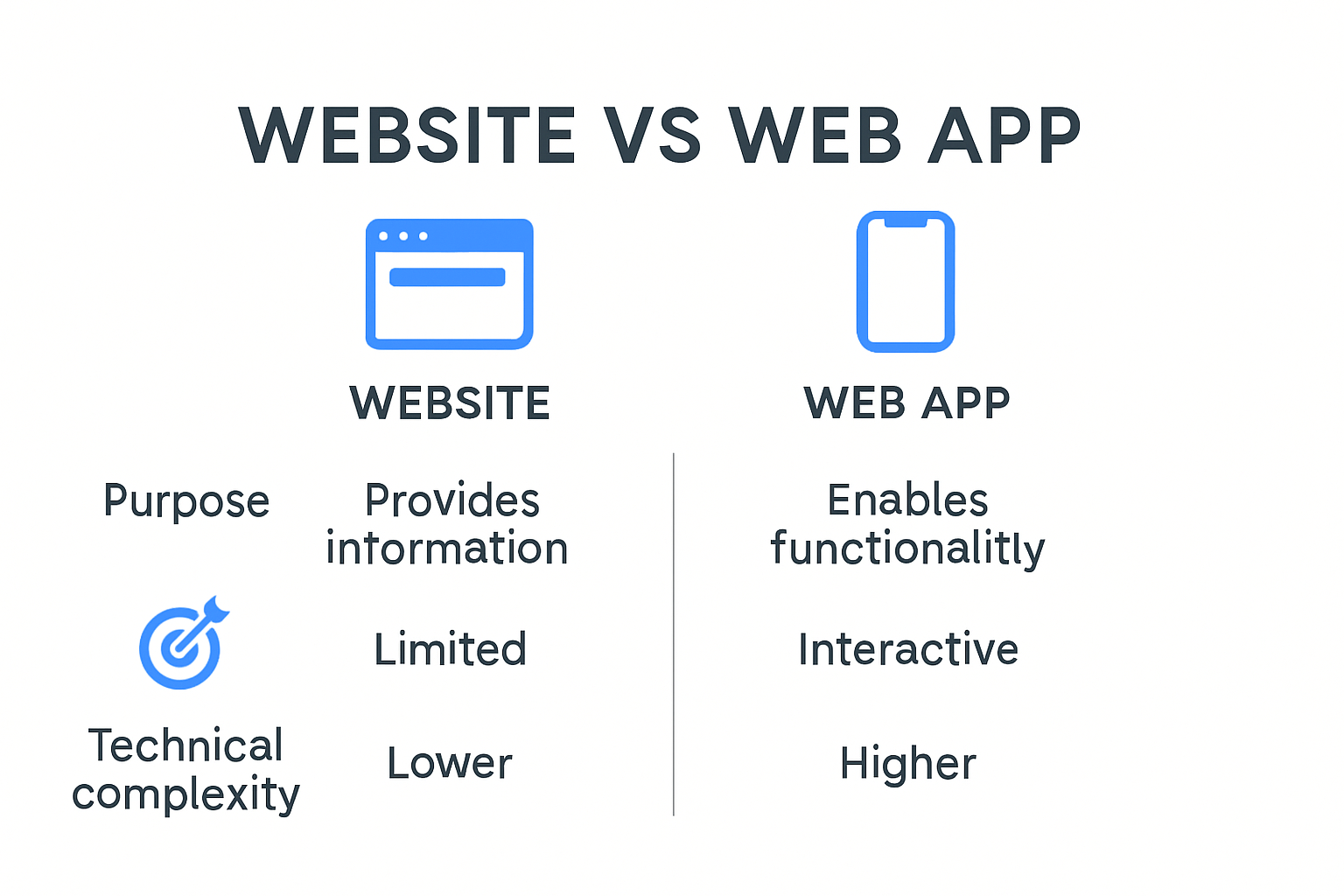Choosing between a website and a web app feels like a small decision for most businesses. Turns out it is anything but simple. Some experts predict that web apps will power more than 70 percent of complex digital services by 2025. But here’s the curveball. Many South African businesses are still pouring resources into traditional websites without realising how much capability they are leaving on the table.
Table of Contents
- Core Differences: Website Vs Web App
- Choosing The Right Solution For Your Business
- Impact On Security, Scalability, And Cost
- Real-World Examples And Use Cases
Quick Summary
| Takeaway | Explanation |
|---|---|
| Web apps enable complex user interactions | Unlike websites, web applications allow users to actively engage, alter data, and participate in digital experiences. |
| Websites serve as informational platforms | Websites are primarily designed for content delivery and basic engagement, providing static information to users. |
| Consider cost implications for development | Websites typically require less investment and simpler frameworks, while web apps involve higher costs due to complexity. |
| Security varies between platforms | Web applications need robust security measures for sensitive data, whereas websites offer basic protection against simple threats. |
| Assess your long-term digital strategy | Your choice between a website and web app should align with business goals and user expectations for sustained engagement. |
Core Differences: Website vs Web App

Understanding the fundamental differences between websites and web applications is crucial for businesses navigating digital technology in 2025. While these digital platforms might seem similar at first glance, they serve distinctly different purposes and possess unique architectural characteristics that impact their functionality, user interaction, and strategic value.
Functional Purpose and User Interaction
Websites primarily function as informational platforms designed to present static content, provide company details, and offer basic user engagement. They typically feature read-only information, such as business descriptions, contact details, product catalogues, and blog posts. Gartner Research notes that traditional websites focus on delivering information efficiently without complex user interactions.
Web applications, conversely, are dynamic, interactive digital environments that enable users to perform specific tasks, manipulate data, and engage in comprehensive digital experiences. These platforms go beyond passive information consumption, offering robust computational capabilities. Users can input data, receive personalised responses, and interact with complex systems. A web app might include functionalities like online banking, project management tools, or e-commerce platforms where users actively participate in creating, modifying, and managing digital content.
Technical Architecture and Complexity
The architectural differences between websites and web apps are profound. Websites are typically built using HTML, CSS, and basic JavaScript, creating relatively straightforward, presentation-focused experiences. They prioritise content delivery and visual design, with minimal backend complexity.
Web applications demand more sophisticated technical infrastructure. They require advanced programming languages, complex backend systems, database integration, and often incorporate microservices architecture. IEEE Software highlights that modern web apps utilise technologies like React, Angular, or Vue.js for frontend development, coupled with robust backend frameworks such as Node.js, Django, or Ruby on Rails.
These technical distinctions mean web apps can handle more complex computational tasks, support real-time data processing, and provide seamless, responsive user experiences across multiple devices. The architecture enables features like user authentication, dynamic content generation, and sophisticated data manipulation that extend far beyond traditional website capabilities.
For South African businesses considering digital transformation, recognising these core differences is essential. While a website might suffice for basic online presence, a web application represents a more strategic investment in digital capability. Read our guide on choosing the right digital solution to understand which platform aligns best with your organisational goals.
The choice between a website and a web app isn’t just technological it’s a strategic decision that can significantly impact your digital engagement, customer experience, and ultimately, business performance in an increasingly digital world.

To help you quickly compare the main characteristics of websites and web applications, here’s a side-by-side summary table based on details in the section above:
| Feature | Website | Web Application |
|---|---|---|
| Primary Function | Information delivery, static content | User interaction, dynamic content, task execution |
| User Interaction | Basic (read-only, contact forms) | Advanced (data input, real-time responses, transactions) |
| Technology Stack | HTML, CSS, basic JavaScript | Advanced JS frameworks (React, Angular), backend (Node.js, Django) |
| Backend Complexity | Minimal | High (database integration, server-side logic, APIs) |
| Scalability | Limited, often static | High, supports modular growth and new features |
| Security Needs | Basic protection (static content) | Robust (encryption, authentication, continuous updates) |
| Example Use Cases | Company info, blog, product catalogue | Banking, e-commerce, project management, custom portals |
Choosing the Right Solution for Your Business
Selecting the appropriate digital platform is a critical strategic decision that can significantly impact your business’s online performance, customer engagement, and overall digital transformation strategy. The choice between a website and a web application is not merely a technical decision but a comprehensive business approach that requires careful consideration of multiple factors.
Strategic Business Requirements and User Experience
Businesses must thoroughly evaluate their specific operational needs, target audience, and digital engagement goals when choosing between a website and a web application. TechTarget suggests that the primary consideration should be the level of user interaction and functionality required.
For businesses seeking simple information dissemination, a website provides an efficient and cost-effective solution. These platforms are ideal for organisations that primarily need to showcase their brand, share contact information, and provide basic company details. Small businesses, professional services, and consultancies often find websites sufficient for their digital presence.
Conversely, businesses requiring complex user interactions, data processing, or personalised user experiences should invest in web applications. GeeksforGeeks highlights that web apps are essential for companies needing advanced features like user authentication, real-time data manipulation, and interactive service delivery.
Cost and Technical Complexity Considerations
The financial and technical investment differs significantly between websites and web applications. Websites are generally less expensive to develop and maintain, requiring minimal backend infrastructure and simpler development frameworks. They can be quickly deployed using template-based platforms or straightforward content management systems.
Web applications demand more sophisticated development approaches, involving complex programming languages, robust backend systems, and ongoing maintenance. freeCodeCamp notes that web apps require more extensive technical expertise, potentially higher development costs, and continuous updates to maintain security and functionality.
For South African businesses, this decision should align with organisational capabilities, budget constraints, and long-term digital strategy. Explore our comprehensive digital solutions to understand how we can support your specific technological requirements.
Ultimately, the right digital solution depends on a nuanced understanding of your business objectives, user expectations, and technological ecosystem. Whether you choose a website or a web application, the goal remains consistent: creating a powerful digital platform that effectively communicates your brand, engages your audience, and drives business growth in an increasingly digital marketplace.
Impact on Security, Scalability, and Cost
In the digital ecosystem of 2025, businesses must critically evaluate how their chosen digital platform impacts security, scalability, and overall financial investment. The fundamental differences between websites and web applications dramatically influence these crucial technological considerations.
Security Landscape and Risk Management
Security represents a paramount concern for digital platforms, with each solution presenting unique vulnerabilities and protection mechanisms. Research from ArXiv reveals that shared hosting environments often compromise website security through inadequate resource isolation. Websites typically offer basic security measures, primarily protecting static content and providing fundamental user protection.
Web applications, conversely, demand comprehensive security architectures. They handle complex user interactions, sensitive data processing, and dynamic authentication protocols. These platforms require robust encryption technologies, multi-factor authentication systems, and continuous security updates. Vamenture emphasizes that web applications necessitate more sophisticated security frameworks to protect against evolving digital threats such as data breaches, cross-site scripting, and sophisticated cyber attacks.
Scalability and Long-Term Investment Strategies
Scalability represents a critical differentiator between websites and web applications. Traditional websites offer limited expansion capabilities, often requiring complete redesigns to accommodate growing business needs. They function effectively for organisations with relatively static digital requirements.
Web applications provide inherent scalability, allowing businesses to incrementally expand their digital infrastructure. VCD Studio highlights that scalable web applications enable organisations to add resources, services, and functionalities without comprehensive system overhauls. This approach allows businesses to adapt their digital platforms dynamically, supporting growth and technological evolution.
From a financial perspective, web applications typically involve higher initial development costs but offer more substantial long-term value. The ability to modularly enhance functionality means businesses can strategically invest in their digital infrastructure, spreading technological investments across multiple phases.
For South African businesses seeking strategic digital solutions, understanding these nuanced differences is crucial. Read our comprehensive guide on digital transformation to explore how your technological choices impact overall business performance.
Ultimately, the decision between a website and web application transcends mere technological preference. It represents a strategic investment in your organisation’s digital future, requiring careful consideration of security requirements, scalability potential, and long-term financial implications. The right choice will empower your business to navigate the complex digital ecosystem effectively, ensuring robust protection, flexible growth, and sustainable technological development.
Below is a summary table highlighting key impacts of websites vs web applications on security, scalability, and cost as discussed above:
| Aspect | Website | Web Application |
|---|---|---|
| Security | Basic measures, mostly for static content | Advanced (encryption, multi-factor authentication, regular updates) |
| Scalability | Limited, may require redesign to grow | Inherently scalable, modular growth possible |
| Initial Cost | Lower, simpler development and maintenance | Higher, due to complex architecture and customisation |
| Long-Term Cost | May increase rapidly with major upgrades | Spread over time with phased enhancements |
| Risk Exposure | Lower (static info), but vulnerable if neglected | Higher (dynamic data, sensitive info), needs robust protection |
Real-World Examples and Use Cases
Understanding the practical applications of websites and web applications provides critical insights into their strategic implementation across various industries. The technological landscape of 2025 demands nuanced approaches to digital solutions that go beyond traditional categorisations.
Industry-Specific Digital Transformation
Different sectors leverage websites and web applications uniquely, reflecting their specific operational requirements. In the financial services sector, websites typically serve informational purposes, presenting product details, interest rates, and basic contact information. Banks like Standard Bank and Nedbank use websites for initial customer engagement, providing overview content and preliminary service descriptions.
Web applications, however, transform financial interactions entirely. Wikipedia highlights that these platforms enable complex banking functionalities like real-time transaction monitoring, secure fund transfers, investment portfolio management, and personalised financial analytics. Online banking platforms such as Discovery Bank’s digital ecosystem demonstrate how web applications can create comprehensive, interactive financial management experiences.
Performance and User Experience Considerations
The technological capabilities of web applications reveal fascinating performance dynamics. Research from ArXiv comparing native and web applications uncovered significant differences in energy consumption and hardware resource utilisation. The study demonstrated that web applications, while versatile, often consume more computational resources compared to native applications.
For e-commerce platforms, this translates into critical user experience implications. Websites like product catalogues serve straightforward browsing needs, while web applications like Takealot or Superbalist offer dynamic shopping experiences. These platforms integrate features such as personalised recommendations, real-time inventory tracking, and seamless payment processing, showcasing the transformative potential of sophisticated web application design.
Moreover, Systematic Literature Review on web application workloads reveals intricate patterns of user interactions. These insights help businesses understand daily and weekly usage trends, enabling more strategic digital infrastructure planning.
For South African businesses seeking to understand digital strategy, explore our comprehensive digital solutions guide to navigate these technological choices effectively.
The distinction between websites and web applications is not merely technical but represents a strategic approach to digital engagement. By understanding these real-world applications, businesses can make informed decisions that align technological investments with specific operational requirements, ultimately delivering superior user experiences and driving digital transformation.
Frequently Asked Questions
What is the main difference between a website and a web application?
Websites are primarily informational platforms designed for content delivery and basic user engagement, while web applications are interactive environments that allow users to perform tasks, manipulate data, and engage with complex systems.
Are web applications more expensive to develop than websites?
Yes, web applications generally require a higher initial investment due to their complex architecture, advanced programming languages, and ongoing maintenance needs compared to simpler websites.
How do security requirements differ between websites and web applications?
Websites typically have basic security measures for static content, whereas web applications require robust security frameworks to protect against threats due to their dynamic nature and sensitive data processing.
When should my business consider investing in a web application instead of a website?
If your business needs complex user interactions, real-time data processing, or personalised user experiences, investing in a web application is advisable as it offers more advanced features than a basic website.
Ready to Upgrade Your Digital Experience in 2025?
If you feel stuck deciding between launching a standard website or a dynamic web application, you are not alone. Many South African businesses miss their true growth potential by settling for platforms that do not fit their actual needs. As highlighted in our article, small technical choices can have a huge impact on your customer engagement, security, and scalability. The pressure to stay competitive is growing, and the right digital platform can set you apart in a crowded online world.
Let Cloudfusion help you take the next step with confidence. Whether you need a simple but powerful informational website or a tailor-made web application designed to handle advanced user interactions, we can turn your vision into a scalable reality. Get expert advice and a custom solution by visiting our web design and development quotation page. Explore our proven process and let us help you achieve your digital goals. Do not wait for your competitors to evolve first—get in touch with Cloudfusion today and start building an online presence that grows with your business.








